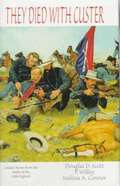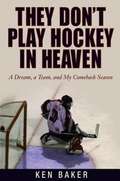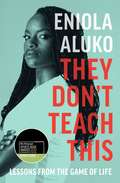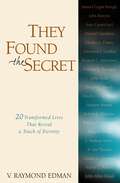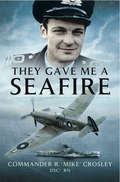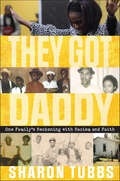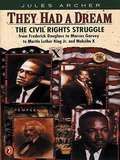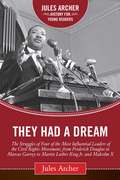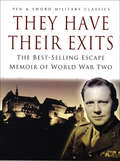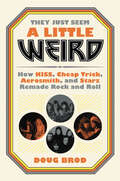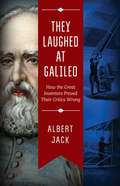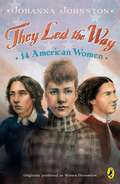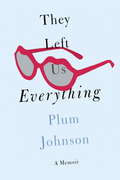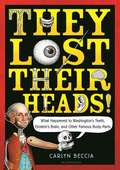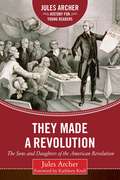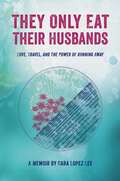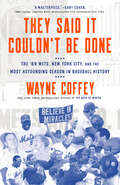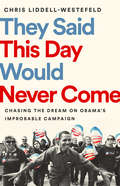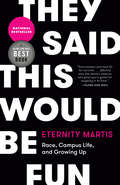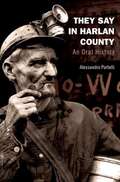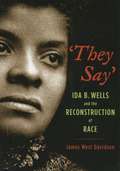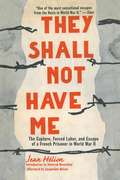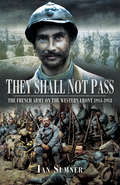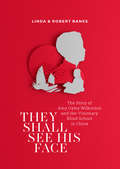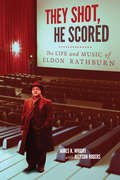- Table View
- List View
They Died with Custer: Soldiers' Bones from the Battle of the Little Bighorn
by Douglas D. Scott P. Willey Melissa A. ConnorMore than a hundred years after the Battle of the Little Bighorn, its secrets continue to unfold. In this book, Douglas D. Scott, P. Willey, and Melissa A. Connor blend historic sources, archeological evidence, and physical data to present new revelations about the men who rode and died with Custer. Although dead men tell no tales, their skeletons whisper entire life stories. Through painstaking analysis of the skeletal remains, the authors construct composite biographies of the soldiers, identifying their true ages, heights, states of health, and how they died. A vast selection of illustrations, including photographs, battlefield maps, drawings, & graphs, enhance the discussion. The authors also move beyond individual stories to consider our views regarding the appropriate treatment for the dead. They explain how Custer Battlefield National Monument, now Little Bighorn Battlefield National Monument, has always reflected shifts in cultural values. The planned monument to the American Indians who fought against the Seventh Cavalry is perhaps the most notable example. THEY DIED WITH CUSTER is important because it humanizes the cavalrymen who until now have been mere statistics. The first study of its kind, this volume not only makes a significant contribution to Little Bighorn scholarship but also offers a general model for new ways to interpret the past. Douglas D. K. Scott is Great Plains Team Leader, Midwest Archeological Center, National Park Service. He is widely know as an expert on military archeology. P. Willey is Professor of Anthropology, Chico State University, California. His specialties include forensic anthropology and human skeletal biology. Melissa A. Connor, an Archeologist with the Midwest Archeological Center, is currently studying the application of archeology to forensic work and the recovery of recent human remains.
They Don't Play Hockey in Heaven: A Dream, A Team, and My Comeback Season
by Ken BakerKen Baker wanted nothing more than to play ice hockey with the pros--until a brain tumor cut his dreams short while in college. After surgery and several years of rehab, Baker, who in high school was a top prospect for the U.S. Olympic team, put his successful journalism career on hold to attempt the seemingly impossible: a comeback. He moved away from his family to become the third-string goalie for the Bakersfield Condors, an AA-level minor-league team in the dusty oil town of Bakersfield, California. At the age of thirty-one, Baker became the oldest rookie in all of pro-hockey, facing 1000-m.p.h. slap shots and long bus rides, hostile fans and cheap motel rooms, body bruises and battle-worn teammates.
They Don't Teach This
by Eniola Aluko*SHORTLISTED FOR THE TELEGRAPH SPORTS BOOK AWARDS*Eni Aluko: 102 appearances for England women's national football team. First female pundit on Match of the Day. UN Women UK ambassador. Guardian columnist. First class honors law degree. Now an inspirational author.They Don't Teach This steps beyond the realms of memoir to explore themes of dual nationality and identity, race and institutional prejudice, success, failure and faith. It is an inspiring manifesto to change the way readers and the future generation choose to view the challenges that come in their life applying life lessons with raw truths of Eni's own personal experience.'A fascinating examination of her multiple identities - British and Nigerian, a girl in a boy's world, footballer and academic, a kid from an estate with upper-middle-class parents, a God-fearing rebel... Aluko does not hold back - and few people from the football establishment emerge with their reputation intact' Guardian
They Found the Secret: Twenty Lives That Reveal a Touch of Eternity
by V. Raymond Edman"The exchanged life." Hudson Taylor first used the term to describe what it means to know Christ as our sufficiency in all things. Taylor is but one of the many Christian luminaries who have discovered Christ as the secret to abundant living. John Bunyan, Andrew Murray, Amy Carmichael, Oswald Chambers, Charles Finney--behind the varied lives and personalities of these and other men and women lies a common theme, a pattern that leads from desperation to the abundant life Jesus promised. From their stories, we too can find the path to deeper faith and a more vital relationship with God. In They Found the Secret, Raymond Edman presents the lives of twenty well-known and little-known Christians. "The details of their experience of the crisis of the deeper life are delightfully different," Edman writes, "yet their testimony to the reality of the joy and power of the Spirit-filled life is unanimous . . . It is [the Lord] who satisfies the longing soul. He is the secret of the exchanged life!"
They Gave Me a Seafire
by Commander R. "Mike" Crosley&“Superb . . . one of the most honest, candid, and truly delightful memoirs . . . the perfect memorial to one of the Fleet Air Arm&’s greats.&”—Aircrew Book Review A classic in every sense of the word, this book charts Commander R. &“Mike&” Crosley&’s service career in the Fleet Air Arm during the entire period of the Second World War. Part of his service saw him in action aboard HMS Eagle, flying Sea Hurricanes on the Harpoon and Pedestal Malta convoys of June and August 1942. It was during this time that he shot down his first enemy aircraft and survived the dramatic sinking of HMS Eagle. From there he graduated on to Seafires, (the Naval equivalent of the Spitfire), and flew this type in Combat Air Patrols over Norway and ramrod strikes from Operation Torch (the invasion of French North Africa in November 1942), through to D-Day in June 1944 in the European Theatre of Operations, and then in the Pacific abroad HMS Implacable as part of the British Pacific Fleet in 1945 until the end of the Pacific War, by which time he had command of his own combined squadron, 801 and 880. They Gave Me a Seafire sets to bring the endeavors of Crosley to a whole new generation of enthusiasts, and it should appeal across the board to fans of aviation, naval history and families and friends of Armed Forces, past and present. &“The fascinating publication details Mike&’s incredible capacity for survival, and sheer skill as a pilot, which were remarked on at the time, securing him a number of decorations.&”—Island Life Magazine
They Got Daddy: One Family's Reckoning with Racism and Faith
by Sharon TubbsAn unforgettable journey through racism and faith across the generations. January 15, 1959—a day that changed one family forever. White supremacists kidnapped and severely beat rural Alabama preacher Israel Page, nearly killing him because he had sued a White sheriff's deputy for injuries suffered in a car crash. After "they" "got Daddy," Israel Page's children began leaving the Jim Crow South, the event leaving an indelible mark on the family and its future. Decades later, the events of that day fueled journalist Sharon Tubbs's epic quest to learn who had "gotten" her mother's daddy and why. They Got Daddy follows Tubbs on her moving journey from Fort Wayne, Indiana, to the back roads and rural churches of Alabama. A powerful revelation of the sustaining and redemptive power of faith and unflinching testimony to the deeply embedded effects of racism across the generations, it demonstrates how the search for the truth can offer a chance at true healing.
They Had a Dream
by Jules ArcherTraces the progression of the civil rights movement and its effect on history through biographical sketches of four prominent and influential African Americans: Frederick Douglass, Marcus Garvey, Martin Luther King, Jr. , and Malcolm X. .
They Had a Dream: The Struggles of Four of the Most Influential Leaders of the Civil Rights Movement, from Frederick Douglass to Marcus Garvey to Martin Luther King Jr. and Malcolm X (Jules Archer History for Young Readers)
by Jules ArcherThe majority of the civil rights movement in the United States occurred in three stages. The first stage began with the slaves in America fighting for their freedom. Frederick Douglass was a key player from the very beginning. Born a slave, Douglass escaped and went on to become one of the most respected abolitionist leaders. After the Civil War, freed slaves fought to overcome the still-prevailing prejudice and persecution. During this phase, Marcus Garvey led the Back to Africa movement, promoting Black Nationalism and black pride among the newly freed people. And in the 1960s, a strong civil rights movement branched in two different directions. The first was headed by Reverend Martin Luther King Jr. , who organized a powerful nonviolent civil disobedience movement to win equal rights through integration. Following a very different path, Malcolm X sought equal rights for blacks through violent confrontation and racial separation. Together, these four men shaped the American civil rights movement. Racism is still a very relevant problem in our country today, and to better understand where we are now and how to make progress in the future, we must first understand where we've come from.
They Have Their Exits: The Best Selling Escape Memoir of World War Two (Pen & Sword Military Classics)
by Airey NeaveThe author of Saturday at M.I.9 and former British soldier recounts his escape from Nazi captivity during World War II in this military memoir. Wounded and captured at Calais in May 1940, Second Lieutenant Airey Neave wasted little time before attempting to escape. Always a thorn in his captors&’ sides, he earned his place in the &“escape-proof&” Colditz Castle. Undeterred, he had the distinction of being the first British officer to make a &“home run,&” via Switzerland, Vichy France, and Spain. Soon back in France working with the French Resistance as a member of M.I.9, rescuing Allied airmen, he found himself playing a leading role saving stranded survivors of 1st Airborne Division at Arnhem. Neave&’s extraordinary memoir continues even after Germany&’s surrender. Having arrested the directors of the mighty Krupp empire, he served with the Nuremburg War Crimes Tribunal where he came into personal contact with leading Nazis, gaining a unique insight into their characters and deeds. If ever there was a great and true story well told, it is They Have Their Exits. Reprinted once again it is a fitting memorial to a man of exceptional energy, initiative, and courage.Praise for They Have Their Exits&“One of the best escape memoirs to emerge from the Second World War, combining the adventure story of most with a deeper examination of the mental impact of captivity and escape, and the stresses and risks all the way along the escape routes.&” —History of War
They Just Seem a Little Weird: How KISS, Cheap Trick, Aerosmith, and Starz Remade Rock and Roll
by Doug BrodIt was the age when heavy-footed, humorless dinosaurs roamed the hard-rock landscape. But that all changed when into these dazed and confused mid-'70s strut-ted four flamboyant bands that reveled in revved-up anthems and flaunted a novel theatricality. In They Just Seem a Little Weird, veteran entertainment journalist Doug Brod offers an eye- and ear-opening look at a crucial moment in music history, when rock became fun again and a gig became a show. This is the story of friends and frenemies who rose, fell, and soared once more, often sharing stages, studios, producers, engineers, managers, agents, roadies, and fans-and who are still collaborating more than forty years on.In the tradition of David Browne's Fire and Rain and Sheila Weller's Girls Like Us, They Just Seem a Little Weird seamlessly interweaves the narratives of KISS, Cheap Trick, and Aerosmith with that of Starz, a criminally neglected band whose fate may have been sealed by a shocking act of violence. This is also the story of how these distinctly American groups-three of them now enshrined in the Rock and Roll Hall of Fame-laid the foundation for two seemingly opposed rock genres: the hair metal of Poison, Skid Row, and Mötley Crüe and the grunge of Nirvana, Alice in Chains, and the Melvins. Deeply researched, and featuring more than 130 new interviews, this book is nothing less than a secret history of classic rock.
They Laughed at Galileo: How the Great Inventors Proved Their Critics Wrong
by Albert JackA humorous account of great inventors and their critics who predicted failure.They Laughed at Galileo takes a humorous and reflective look at one thousand years of the development of humankind: those who dreamt, those who taught, those who opposed, and those who, ultimately, did.At some point in modern history, each and every one of our inventions and discoveries was first envisioned and then developed by a single person, or a handful of people, who dreamt of the seemingly impossible. For them, the future was clear and obvious, but for the vast majority, including the acknowledged experts of their days, such belief was sheer folly.For just about everything that has improved our modern lifestyles in a way that our ancestors could not possibly imagine, there was once a lone dreamer proclaiming, "It can be done.” That dreamer was nearly always opposed by a team of "enlightened” contemporaries publicly declaring, "It cannot be done.” Well, yes it could.Marconi’s wireless radio transmissions were initially deemed pointless. Edward L. Drake’s eventual success on August 27, 1859, was called the day "the crazy man first struck oil.” Louis Pasteur’s theory of germs was considered a "ridiculous fiction.” Each of these inventions has had a profound effect on the course of human history, and each one was rejected, resisted, and ridiculed in its day. Ultimately, the innovators who brought these into existence provided invaluable contributions to science and the culture of humankind.
They Led the Way: 14 American Women
by Johanna JohnstonThe battle for equal rights began hundreds of years ago and there were many strong, influential women who fought hard for their freedom and for the freedom of others. Here are the stories of fourteen of these women who stood up for what they believed in. From Emma Willard, who started the first college for women, and Abigail Adams, who voiced her belief that women should have the same rights as men, to Harriet Beecher Stowe, who wrote a book that helped to abolish slavery, these are the inspiring stories of women who changed a nation.
They Left Us Everything: A Memoir
by Plum JohnsonA warm, heartfelt memoir of family, loss, and a house jam-packed with decades of goods and memories. After almost twenty years of caring for elderly parents--first for their senile father, and then for their cantankerous ninety-three-year old mother--author Plum Johnson and her three younger brothers have finally fallen to their middle-aged knees with conflicted feelings of grief and relief. Now they must empty and sell the beloved family home, twenty-three rooms bulging with history, antiques, and oxygen tanks. Plum thought: How tough will that be? I know how to buy garbage bags.But the task turns out to be much harder and more rewarding than she ever imagined. Items from childhood trigger difficult memories of her eccentric family growing up in the 1950s and '60s, but unearthing new facts about her parents helps her reconcile those relationships, with a more accepting perspective about who they were and what they valued.They Left Us Everything is a funny, touching memoir about the importance of preserving family history to make sense of the past, and nurturing family bonds to safeguard the future.From the Hardcover edition.
They Lost Their Heads!: What Happened to Washington's Teeth, Einstein's Brain, and Other Famous Body Parts
by Carlyn BecciaFrom the kidnapping of Einstein's brain to the horrifying end of Louis XIV's heart, the mysteries surrounding some of history's most famous body parts range from medical to macabre. Carlyn Beccia explores the misadventures of noteworthy body parts through history and springboards to exploring STEM topics such as forensics, DNA testing, brain science, organ donation, and cloning. The engaging tone, wonderfully creepy subject matter, and delightfully detailed art are sure to capture even the most reluctant readers.
They Made a Revolution: The Sons and Daughters of the American Revolution (Jules Archer History for Young Readers)
by Kathleen Krull Jules ArcherThe founding fathers and mothers of the United States were not, as history often makes them out to be, stuffy cardboard figures of virtue and nobility. They Made a Revolution introduces them as the real people they were-complete with their inevitable flaws and weaknesses. Through their letters, diaries, and reminiscences, discover what was going on in the minds of this country’s revolutionary leaders as they committed treason against the most powerful nation on earth, risking their lives for the sake of freedom. Meet "The Sly Fox,” Sam Adams; "The Rich Rebel,” John Hancock; "The Silver-Tongued Bumpkin,” Patrick Henry; and the very brave Abigail Adams and full-of-secrets Martha Washington. Each of these characters comes alive in this fabulous collection of historical biographies.These are the stories of the courageous men and women who stood up to the British king and made a revolution happen. To England, they were traitors. To the United States, they became patriots.
They Only Eat Their Husbands: Love, Travel, and the Power of Running Away
by Cara Lopez LeeAfter a lover threatens to kill her, 26-year-old Cara Lopez Lee runs away to Alaska. There, she finds herself in a complicated love triangle with two alcoholics: Sean, the martial artist, and Chance, the paramedic. Nine years later, sick of love and the abuse that destroyed it, she runs away again, this time to backpack alone around the world. Recounting one woman&’s journey to self-discovery with dazzling honesty and humor, this memoir follows her year-long trek through Thailand, China, Nepal, Spain, and Ireland.
They Said It Couldn't Be Done: The '69 Mets, New York City, and the Most Astounding Season in Baseball History
by Wayne Coffey"A masterpiece."—GARY COHEN, Emmy Award-winning Mets broadcaster for SportsNet New YorkThe astonishing story of the 1969 Miracle Mets, the most improbable World Series champions in baseball history, from Wayne Coffey, the best-selling author of The Boys of Winter. Here is an iconic season brought back to riveting life on its 50th anniversary. Gracefully told with unprecedented depth and detail and set against the roiling backdrop of the Vietnam War, the wonder of the moon landing and the music-filled mayhem of Woodstock, They Said It Couldn’t Be Done is the finely wrought, uplifting chronicle of a brilliant manager, Gil Hodges, and his overachieving roster of heroes, who together produced a triumph for the ages.The story of the 1969 New York Mets’ season has long since entered sports lore as one of the most remarkable of all time. But beyond the “miracle” is a compelling narrative of an unlikely collection of players and the hallowed manager who inspired them to greatness. Future Hall of Fame ace Tom Seaver snagged the biggest headlines, but the enduring richness of the story lies in the core of a team comprised of untested youngsters, lightly regarded veterans, and four Southern-born African-American stalwarts who came of age in the shadow of Jackie Robinson. Most of the Mets regulars were improbable candidates for baseball stardom. The number two starting pitcher, Jerry Koosman, grew up on a Minnesota farm, never played high-school ball, and was only discovered because of a tip from a Mets’ usher. Outfielder Ron Swoboda was known for long home runs and piles of strikeouts, until he turned into a glove wizard when it mattered most. All of these men were galvanized by their manager: the sainted former Brooklyn Dodger Gil Hodges, whose fundamental belief in the power of every man on the roster, no matter his stats, helped backup players like Al Weis and J.C. Martin become October heroes. As the Mets powered through the season to reach a World Series against the best-in-a-generation Baltimore Orioles, Hodges’s steady hand guided a team that had very recently been the league laughingstock to an improbable, electrifying shot at sports immortality. In these pages, bestselling author Wayne Coffey has captured the voices of players and fans, reporters and umpires, to bring to life a moment when a championship could descend on a city like magic, and when a baseball legend was authored one inning at a time.
They Said This Day Would Never Come: Chasing the Dream on Obama's Improbable Campaign
by Chris Liddell-WestefeldThe thrilling, unlikely story of Barack Obama's first presidential campaign, as told by the volunteers and staff who propelled the longshot candidate to the presidencyIn the year leading up to the Iowa caucuses, few thought a freshman senator named Barack Hussein Obama would be able to win the Democratic nomination--not to mention become the most popular leader in the world.But something was stirring. Hundreds of young people from all over the country began assembling first in Iowa. These "kids" became the foundation of one of the most improbable presidential campaigns of the modern era.Chris Liddell-Westefeld was one of those kids. He and thousands of other staff and volunteers dedicated every minute of their time, intelligence, and resources to help elect Barack Obama, as what started in the midwest spread nationwide. Drawn from more than 200 interviews with alumni including David Axelrod, David Plouffe, Alyssa Mastromonaco, Dan Pfeiffer, Valerie Jarrett, Josh Earnest, Tommy Vietor, Jon Favreau, and President Obama himself, They Said This Day Would Never Come takes readers deep inside the most inspirational presidential campaign in recent history.
They Said This Would Be Fun: Race, Campus Life, and Growing Up
by Eternity MartisA powerful, moving memoir about what it's like to be a student of colour on a predominantly white campus.A booksmart kid from Toronto, Eternity Martis was excited to move away to Western University for her undergraduate degree. But as one of the few Black students there, she soon discovered that the campus experiences she'd seen in movies were far more complex in reality. Over the next four years, Eternity learned more about what someone like her brought out in other people than she did about herself. She was confronted by white students in blackface at parties, dealt with being the only person of colour in class and was tokenized by her romantic partners. She heard racial slurs in bars, on the street, and during lectures. And she gathered labels she never asked for: Abuse survivor. Token. Bad feminist. But, by graduation, she found an unshakeable sense of self--and a support network of other women of colour.Using her award-winning reporting skills, Eternity connects her own experience to the systemic issues plaguing students today. It's a memoir of pain, but also resilience.
They Say in Harlan County: An Oral History
by Alessandro PortelliMade famous in the 1976 documentary Harlan County USA, this pocket of Appalachian coal country has been home to generations of miners--and to some of the most bitter labor battles of the 20th century. It has also produced a rich tradition of protest songs and a wealth of fascinating culture and custom that has remained largely undiscovered by outsiders, until now. <p><p> They Say in Harlan County is not a book about coal miners so much as a dialogue in which more than 150 Harlan County women and men tell the story of their region, from pioneer times through the dramatic strikes of the 1930s and '70s, up to the present. Alessandro Portelli draws on 25 years of original interviews to take readers into the mines and inside the lives of those who work, suffer, and often die in them--from black lung, falling rock, suffocation, or simply from work that can be literally backbreaking. The book is structured as a vivid montage of all these voices--stoic, outraged, grief-stricken, defiant--skillfully interwoven with documents from archives, newspapers, literary works, and the author's own participating and critical voice. Portelli uncovers the whole history and memory of the United States in this one symbolic place, through settlement, civil war, slavery, industrialization, immigration, labor conflict, technological change, migration, strip mining, environmental and social crises, and resistance. And as hot-button issues like mountain-top removal and the use of "clean coal" continue to hit the news, the history of Harlan County--especially as seen through the eyes of those who lived it--is becoming increasingly important. <p> With rare emotional immediacy, gripping narratives, and unforgettable characters, They Say in Harlan County tells the real story of a culture, the resilience of its people, and the human costs of coal mining.
They Say: Ida B. Wells and the Reconstruction of Race
by James West DavidsonIn 'They Say,' James West Davidson recounts the first thirty years in the passionate life of Ida B. Wells--as well as the story of the great struggle over the meaning of race in post-emancipation America. Davidson captures the breathtaking and often chaotic changes that swept the South as Wells grew up in Holly Springs, Mississippi: the spread of education among free blacks, the rise of political activism, and the bitter struggles for equality in the face of entrenched social custom. When Wells came of age she moved to bustling Memphis, where her quest for personal fulfillment was thwarted as whites increasingly used race as a barrier to separate blacks from mainstream America. Davidson traces the crosscurrents of these cultural conflicts through Wells's forceful personality, intertwining her struggle to define herself with her early courageous, and often audacious, behavior. When a conductor threw her off a train for refusing to sit in the segregated car, she sued the railroad--and won. When she protested conditions in segregated Memphis schools, she was fired--and took up journalism. And in 1892, when an explosive lynching rocked Memphis, Wells embarked fully on the career for which she is now remembered, as outspoken anti-lynching writer and lecturer. Period photographs from postcards, newspapers, and Wells's own diary further engage readers in this dynamic story. Richly researched and deftly written, the book offers a gripping portrait of the young Ida B. Wells, who directly encountered and influenced the evolving significance of race in America.
They Shall Not Have Me: The Capture, Forced Labor, and Escape of a French Prisoner in World War II
by Deborah Rosenthal Jacqueline Helion Jean HelionThe French painter Jean Hélion's unique and deeply moving account of his experiences in Nazi prisoner-of-war camps prefigures the even darker stories that would emerge from the concentration camps. This serious adventure tale begins with Hélion's infantry platoon fleeing from the German army and warplanes as they advanced through France in the early days of the war. The soldiers chant as they march and run, "They shall not have me!" but are quickly captured and sent to hard labor. Writing in English in 1943, after his risky escape to freedom in the United States, Hélion vividly depicts the sights, sounds, and smells of the camps, and shrewdly sizes up both captors and captured. In the deep humanity, humor, and unsentimental intelligence of his observations, we can recognize the artist whose long career included friendships with the likes of Mondrian, Giacometti, and Balthus, and an important role in shaping modern art movements. Hélion's picture of almost two years without his art is a self-portrait of the artist as a man.
They Shall Not Pass: The French Army on the Western Front, 1914–1918
by Ian SumnerThis graphic collection of first-hand accounts sheds new light on the experiences of the French army during the Great War. It reveals in authentic detail the perceptions and emotions of soldiers and civilians who were caught up in the most destructive conflict the world had ever seen. Their testimony gives a striking insight into the mentality of the troops and their experience of combat, their emotional ties to their relatives at home, their opinions about their commanders and their fellow soldiers, the appalling conditions and dangers they endured, and their attitude to their German enemy. In their own words, in diaries, letters, reports and memoirs - most of which have never been published in English before - they offer a fascinating inside view of the massive life-and-death struggle that took place on the Western Front. Ian Sumner provides a concise narrative of the war in order to give a clear context to the eyewitness material. In effect the reader is carried through the experience of each phase of the war on the Western Front and sees events as soldiers and civilians saw them at the time. This emphasis on eyewitness accounts provides an approach to the subject that is completely new for an English-language publication. The authors pioneering work will appeal to readers who may know something about the British and German armies on the Western Front, but little about the French army which bore the brunt of the fighting on the allied side. His book represents a milestone in publishing on the Great War.
They Shall See His Face: The Story of Amy Oxley Wilkinson and Her Visionary Blind School in China (Global Stories)
by Robert Banks Linda Banks<P>Amy Oxley Wilkinson was arguably the most widely known female Australian missionary in China and the West in the early 20th century. She was the great granddaughter of colonial chaplain Samuel Marsden and granddaughter of celebrated explorer John Oxley. After rescuing an abandoned blind boy, she founded an innovative Blind Boys School in Fuzhou which is now a major institution in Fujian Province. Her husband Dr George Wilkinson set up the city’s first hospital and introduced a program to address the pervasive curse of opium addiction. <P>Amy’s holistic and vocational approach to disability education brought her national and later international recognition. In 1920, the president of the new Chinese republic awarded her the Order of the Golden Grain, the highest honour a foreigner could receive. Two years later, Amy and the School’s brass band were presented to Queen Mary in England. <P>Amy’s story highlights the significance of Australia’s contribution to the development of early modern China and is a challenge to anyone committed to making their life count for others.
They Shot, He Scored: The Life and Music of Eldon Rathburn
by James K. WrightEldon Davis Rathburn (1916-2008), one of the most multi-dimensional, prolific, and endlessly fascinating composers of the twentieth century, wrote more music than any other Canadian composer of his generation. During a long and productive career that spanned seventy-five years, Rathburn served for thirty years as a staff composer with the National Film Board of Canada (1947-76), scored the first generation of IMAX films, and created a diverse catalogue of orchestral and chamber works. With the aid of extensive archival and documentary materials, They Shot, He Scored chronicles Rathburn's life and works, beginning with his formative years in Saint John, New Brunswick, and his breakthrough in Los Angeles in connection with Arnold Schoenberg and the LA Philharmonic Orchestra. The book follows his work at the NFB, his close encounters with some of the most celebrated international figures in his field, and his collaboration with the team of innovators who launched the IMAX film corporation. James Wright undertakes a close analytical reading of Rathburn's film and concert scores to outline his methods, compositional techniques, influences, and idiosyncratic approach to instrumentation, as well as his proto-postmodern proclivity for borrowing from diverse styles and genres. Authoritative and insightful, They Shot, He Scored illuminates the extraordinary career of an unsung creative force in the film and music industry.
